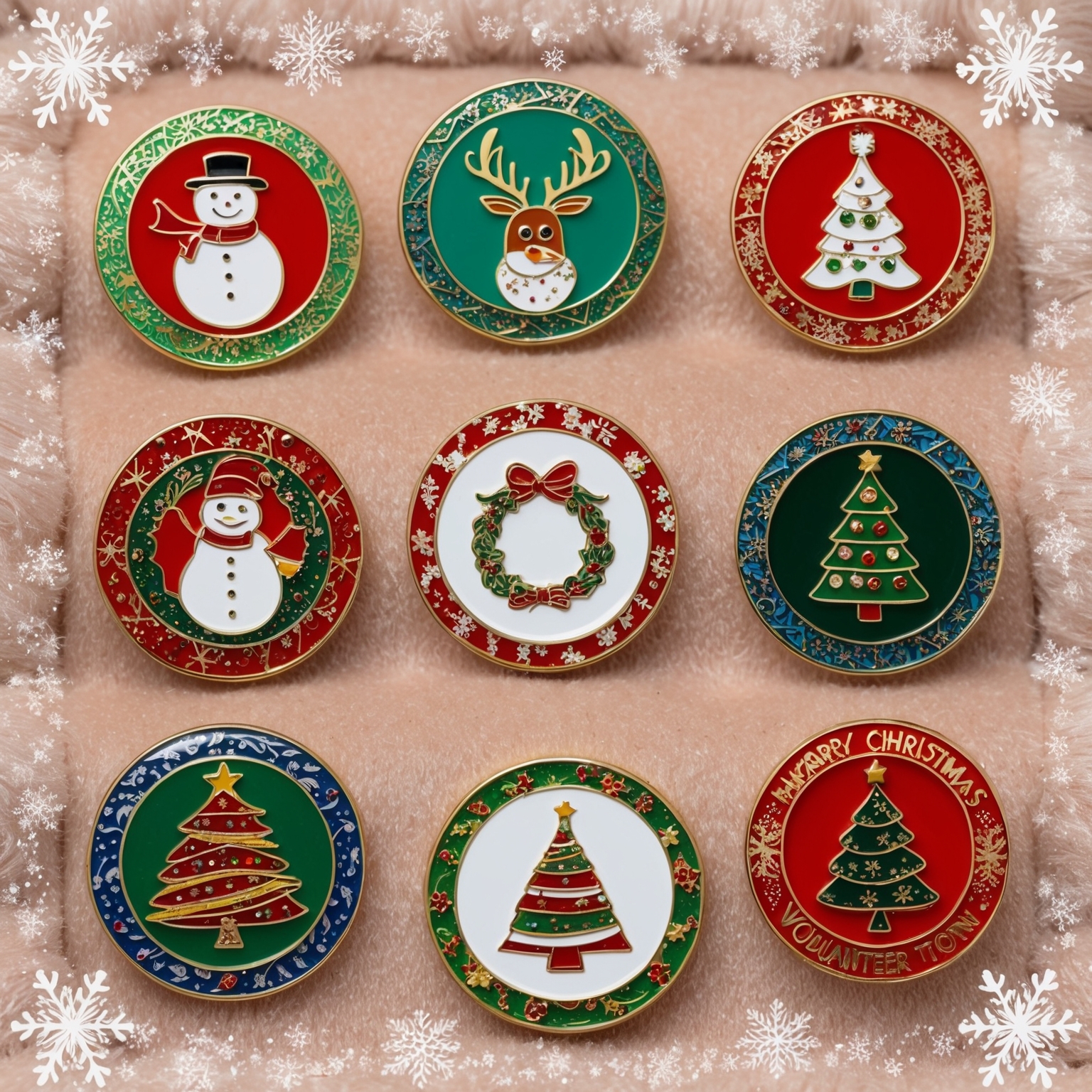Lapel pins have long been cherished as symbols of identity, achievement, and style. Whether used to commemorate a special event, signify membership in an organization, or simply add a touch of flair to an outfit, lapel pins hold significant value for collectors and enthusiasts alike. However, as the popularity of lapel pins continues to grow, so too does the risk of encountering counterfeit or fake lapel pins in the market.
For collectors and buyers, distinguishing between authentic and fake lapel pins is crucial. Fake lapel pins not only undermine the value of a collection but can also result in financial loss and disappointment. Fortunately, with the right knowledge and attention to detail, buyers can learn to detect fake lapel pins and make informed purchasing decisions.
This comprehensive guide will walk you through everything you need to know about detecting fake lapel pins, from understanding the common characteristics of counterfeit pins to learning how to verify authenticity. Whether you’re a seasoned collector or a first-time buyer, this guide will equip you with the tools and knowledge to protect yourself from fakes and ensure that your lapel pin collection remains genuine and valuable.
Understanding the Appeal of Lapel Pins
Before diving into the specifics of detecting fake lapel pins, it’s important to understand why lapel pins are so appealing and why they are targeted by counterfeiters. Lapel pins are highly collectible items that hold both sentimental and monetary value. Here’s why lapel pins are so sought after:
1. Symbolism and Identity
Lapel pins are often used to symbolize membership in an organization, represent an achievement, or express personal values and beliefs. For many people, wearing a lapel pin is a way to proudly display their identity, whether it’s through a military insignia, a sports team logo, or a cultural symbol.
2. Rarity and Limited Editions
Many lapel pins are produced in limited quantities, making them rare and highly collectible. Limited edition pins, such as those released to commemorate a special event or anniversary, are particularly sought after by collectors. The rarity of these pins adds to their value, making them attractive targets for counterfeiters.
3. Artistic and Aesthetic Appeal
Lapel pins are small works of art, often featuring intricate designs, vibrant colors, and unique shapes. Collectors appreciate the craftsmanship and creativity that goes into making high-quality lapel pins, which can be displayed as part of a collection or worn as a fashion accessory.
4. Investment Potential
For some collectors, lapel pins are not only a passion but also an investment. Rare and valuable pins can appreciate in value over time, especially if they are well-preserved and in high demand. This potential for financial gain makes the lapel pin market an attractive one, but it also attracts counterfeiters looking to take advantage of unsuspecting buyers.
Given the appeal and value of lapel pins, it’s no surprise that fake lapel pins are a concern for collectors. Understanding the motivations behind counterfeiting and the characteristics of genuine lapel pins is the first step in protecting yourself from fakes.
Common Characteristics of Fake Lapel Pins
Fake lapel pins can be surprisingly convincing, especially to the untrained eye. However, there are several common characteristics that can help you identify counterfeit pins. By familiarizing yourself with these signs, you can develop a keen eye for spotting fakes and avoid falling victim to counterfeiters.
1. Poor Craftsmanship and Quality
One of the most telling signs of a fake lapel pin is poor craftsmanship and quality. Genuine lapel pins are made with precision and attention to detail, while fake pins often exhibit flaws and inconsistencies.
- Rough Edges: Fake lapel pins may have rough, uneven edges that are a result of poor manufacturing processes. Genuine pins, on the other hand, will have smooth, clean edges with no jagged or sharp areas.
- Blurry or Fuzzy Designs: Counterfeit pins may have designs that appear blurry, fuzzy, or poorly defined. This is often due to low-quality printing or engraving methods. In contrast, genuine pins will have sharp, clear designs with crisp lines and details.
- Inconsistent Coloring: Fake lapel pins may exhibit inconsistent coloring, with uneven or patchy enamel. Genuine pins will have even, vibrant colors that are consistent across the entire design.
- Weak or Flimsy Material: Counterfeit pins may be made from low-quality materials that feel weak, flimsy, or lightweight. Genuine lapel pins are typically made from durable metals such as brass, copper, or zinc alloy, and will have a solid, substantial feel.
When examining a lapel pin, pay close attention to the craftsmanship and overall quality. If the pin appears poorly made or lacks the attention to detail expected of a genuine item, it may be a fake.
2. Incorrect or Inconsistent Markings
Markings on a lapel pin, such as logos, hallmarks, or serial numbers, can provide important clues about its authenticity. Counterfeiters often make mistakes or inconsistencies in these markings, which can be a red flag.
- Incorrect Logos: Fake lapel pins may feature logos that are slightly off in terms of design, font, or size. Compare the logo on the pin to a known authentic version to check for discrepancies.
- Missing Hallmarks or Serial Numbers: Many genuine lapel pins, especially those produced by well-known manufacturers, will have hallmarks or serial numbers stamped on the back. Fake pins may lack these markings altogether or feature poorly executed imitations.
- Misspellings or Typographical Errors: Counterfeit pins may have misspellings or typographical errors in the text, such as the name of a brand, organization, or event. Genuine pins will have correct and consistent spelling.
Examine the markings on the lapel pin closely and compare them to known authentic examples. Any inconsistencies or errors should raise suspicion.
3. Discrepancies in Size and Shape
Fake lapel pins may differ in size and shape from the genuine versions. Even small discrepancies can indicate that a pin is not authentic.
- Incorrect Dimensions: Measure the dimensions of the lapel pin and compare them to the specifications provided by the original manufacturer. A fake pin may be slightly larger or smaller than the genuine version.
- Altered Shapes: Some counterfeiters may attempt to replicate a genuine design but alter the shape slightly to avoid copyright infringement. For example, a circular pin might be made slightly oval, or the edges may be rounded instead of sharp.
If possible, compare the pin to a known authentic version to check for any differences in size or shape. Even minor discrepancies can be a sign of a fake lapel pin.
4. Inaccurate or Missing Backing
The backing of a lapel pin can also provide important clues about its authenticity. Genuine lapel pins typically have specific types of backings that are consistent with the manufacturer or brand.
- Incorrect Backing Type: Different types of lapel pins may use different backings, such as butterfly clutches, rubber clutches, or safety pins. A fake lapel pin may use an incorrect or low-quality backing that is inconsistent with the original design.
- Missing or Incorrect Manufacturer Markings: Some genuine lapel pins will have the manufacturer’s logo or name stamped on the backing. Fake pins may lack these markings or feature incorrect ones.
Examine the backing of the lapel pin and compare it to known authentic examples. Any discrepancies in the type, quality, or markings of the backing can be a sign of a fake pin.
Tips for Verifying the Authenticity of Lapel Pins
In addition to recognizing the common characteristics of fake lapel pins, there are several steps you can take to verify the authenticity of a lapel pin before making a purchase. These tips can help you avoid buying counterfeit pins and ensure that your collection remains genuine.
1. Research the Manufacturer or Brand
One of the most important steps in verifying the authenticity of a lapel pin is researching the manufacturer or brand. Understanding the history, reputation, and production practices of the brand can provide valuable context for evaluating the pin’s authenticity.
- Official Websites and Resources: Visit the official website of the manufacturer or brand to learn more about their lapel pins, including information about designs, materials, and markings. Some brands may also provide guides or databases for verifying authentic products.
- Collector Communities: Join online collector communities or forums where experienced collectors share their knowledge and tips for identifying authentic lapel pins. These communities can be a valuable resource for learning about specific brands and their products.
By researching the manufacturer or brand, you can gain a better understanding of what to look for in an authentic lapel pin and avoid falling for counterfeits.
2. Compare to Known Authentic Pins
If possible, compare the lapel pin in question to a known authentic version. This can help you identify any discrepancies in design, size, markings, or materials that may indicate a fake pin.
- Side-by-Side Comparison: Place the lapel pin next to a known authentic pin and compare them closely. Look for differences in craftsmanship, quality, and details that may not be immediately apparent.
- Photographic Comparison: If you don’t have access to a physical authentic pin, use high-quality photographs from reliable sources to compare the design. Pay attention to even the smallest details, as these can be telltale signs of a fake.
A direct comparison with a known authentic pin is one of the most effective ways to identify counterfeit lapel pins.
3. Check for Documentation and Packaging
Many genuine lapel pins come with documentation, such as certificates of authenticity, serial numbers, or original packaging. These items can provide additional proof of authenticity and help you verify the pin’s origin.
- Certificates of Authenticity: Some limited edition or collectible lapel pins come with a certificate of authenticity issued by the manufacturer or brand. Check that the certificate matches the details of the pin and is from a reputable source.
- Original Packaging: Genuine lapel pins are often sold in branded packaging that includes the manufacturer’s logo, name, and other identifying information. Counterfeit pins may lack original packaging or come in packaging that appears cheap or poorly made.
Always ask the seller for any documentation or packaging that accompanies the lapel pin. The absence of these items may be a red flag, especially for high-value or collectible pins.
4. Purchase from Reputable Sellers
One of the best ways to avoid buying fake lapel pins is to purchase from reputable sellers who have a proven track record of selling authentic products. Whether you’re buying from a physical store, an online retailer, or a private seller, it’s important to do your due diligence.
- Established Retailers: Purchase lapel pins from established retailers with a reputation for selling genuine products. Look for retailers that specialize in collectibles, memorabilia, or lapel pins and have positive reviews from customers.
- Authorized Dealers: Some brands or manufacturers have authorized dealers who are certified to sell their products. Buying from an authorized dealer can provide added assurance that the lapel pin is authentic.
- Private Sellers: If buying from a private seller, ask for references, reviews, or proof of authenticity. Be cautious of sellers who are unwilling to provide information or who offer prices that seem too good to be true.
By purchasing from reputable sellers, you can reduce the risk of buying fake lapel pins and increase the likelihood of receiving a genuine product.
5. Trust Your Instincts
Finally, trust your instincts when evaluating a lapel pin. If something about the pin or the seller feels off, it’s better to walk away than to take the risk. Your intuition, combined with the knowledge you’ve gained, can be a powerful tool in detecting fake lapel pins.
- Too Good to Be True: If the price of the lapel pin is significantly lower than expected, or if the seller is offering deals that seem too good to be true, proceed with caution. Counterfeiters often lure buyers with low prices, but the risk of receiving a fake pin is high.
- Unusual Behavior: Be wary of sellers who pressure you to make a quick decision, are vague about the details of the pin, or are unwilling to provide additional information or documentation. These behaviors may indicate that the seller is not trustworthy.
Trusting your instincts can help you avoid making a purchase that you’ll later regret and ensure that your lapel pin collection remains authentic and valuable.
Common Types of Fake Lapel Pins and How to Avoid Them
While fake lapel pins can come in many forms, there are certain types of counterfeits that are more common than others. Understanding these common types of fake lapel pins can help you stay vigilant and avoid falling victim to counterfeiters.
1. Replica Pins
Replica pins are imitations of genuine lapel pins, often produced to look as close to the original as possible. These pins are typically made from lower-quality materials and may lack the fine details and craftsmanship of the authentic versions.
- How to Avoid: Research the specific pin you are interested in and familiarize yourself with its characteristics. Look for discrepancies in design, materials, and markings that may indicate a replica. If the price of the pin is significantly lower than expected, it may be a replica.
2. Unauthorized Copies
Unauthorized copies of lapel pins are produced without the permission of the original manufacturer or brand. These pins may use designs, logos, or trademarks that belong to the brand, but they are not official products.
- How to Avoid: Purchase lapel pins from authorized dealers or retailers who have a direct relationship with the brand. Verify the pin’s authenticity through the manufacturer’s website or by contacting customer service.
3. Fantasy Pins
Fantasy pins are lapel pins that are created by counterfeiters to mimic the style of popular pins, but they are not based on any genuine design. These pins may feature similar logos, colors, or themes, but they are not official products.
- How to Avoid: Be cautious of lapel pins that feature designs or themes that seem familiar but don’t match any known official products. Research the pin to see if it is listed on the manufacturer’s website or in collector guides.
4. Bootleg Pins
Bootleg pins are unlicensed lapel pins that use copyrighted designs, characters, or logos without permission. These pins are often sold at lower prices and may lack the quality and durability of official products.
- How to Avoid: Avoid purchasing lapel pins from unofficial or unauthorized sources, such as street vendors or online marketplaces with questionable reputations. Stick to reputable sellers and authorized dealers.
The Risks of Buying Fake Lapel Pins
Purchasing fake lapel pins can have several negative consequences, both financially and emotionally. Understanding the risks of buying fake lapel pins can help you make informed decisions and protect your collection.
1. Financial Loss
One of the most obvious risks of buying fake lapel pins is financial loss. Counterfeit pins are often sold at prices that are lower than genuine products, but they still represent a waste of money if they are not what they claim to be. Additionally, fake pins have little to no resale value, making them a poor investment.
2. Damage to Your Collection
If you’re a collector, fake lapel pins can damage the integrity and value of your collection. The presence of counterfeit pins can devalue your collection and make it more difficult to sell or trade genuine items in the future.
3. Legal and Ethical Concerns
Purchasing fake lapel pins, even unknowingly, can raise legal and ethical concerns. Counterfeit products infringe on the intellectual property rights of brands and creators, and supporting the counterfeit market can contribute to the proliferation of illegal and unethical practices.
4. Emotional Disappointment
Finally, buying a fake lapel pin can lead to emotional disappointment, especially if the pin was intended as a meaningful gift or a cherished addition to your collection. Discovering that a pin is not genuine can be disheartening and undermine the joy of collecting.
Protecting Yourself from Fake Lapel Pins
As lapel pins continue to grow in popularity, the risk of encountering fake lapel pins in the market also increases. However, by educating yourself about the common characteristics of counterfeit pins, verifying authenticity, and purchasing from reputable sources, you can protect yourself from fakes and ensure that your lapel pin collection remains genuine and valuable.
Remember, the key to detecting fake lapel pins is a combination of knowledge, attention to detail, and intuition. By following the tips and strategies outlined in this guide, you can confidently navigate the lapel pin market and make informed purchasing decisions that enhance your collection.
Whether you’re a seasoned collector or a first-time buyer, the knowledge you’ve gained from this guide will empower you to detect fake lapel pins and protect your investment. With the right approach, you can continue to enjoy the beauty, symbolism, and value of genuine lapel pins for years to come.
If you are interested in buying high quality custom trading pins, you can call us at 1-800-641-1299 or fill out a FREE quote form.







